Top 10 things to know about the Day of the Dead

We’ve all heard about the Day of the Dead or seen the classic sugar skull paintings—but what does this celebration really represent?
BYLOGAN WARDPUBLISHED OCTOBER 26, 2017• 13 MIN READ
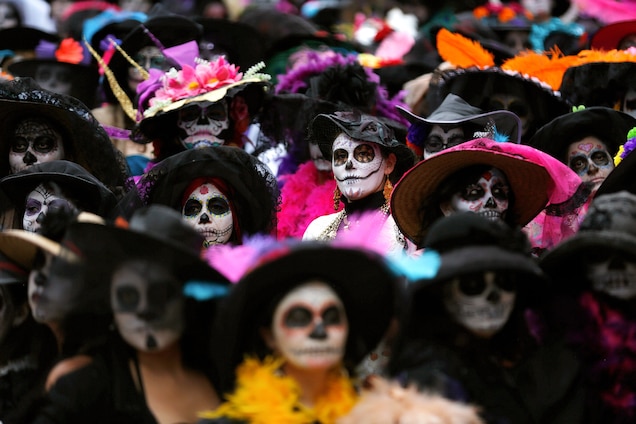
Here’s one thing we know: Día de los Muertos, or Day of the Dead, is not a Mexican version of Halloween.
Though related, the two annual events differ greatly in traditions and tone. Whereas Halloween is a dark night of terror and mischief, Day of the Dead festivities unfold over two days in an explosion of color and life-affirming joy. Sure, the theme is death, but the point is to demonstrate love and respect for deceased family members. In towns and cities throughout Mexico, revelers don funky makeup and costumes, hold parades and parties, sing and dance, and make offerings to lost loved ones.about:blank

1:51
WHAT IS DAY OF THE DEAD?Día de los Muertos, or Day of the Dead, is a celebration of life and death. While the holiday originated in Mexico, it is celebrated all over Latin America with colorful calaveras (skulls) and calacas (skeletons). Learn how the Day of the Dead started and the traditions that make it unique.
The rituals are rife with symbolic meaning. The more you understand about this feast for the senses, the more you will appreciate it. Here are 10 essential things you should know about Mexico’s most colorful annual event. [See more stunning photos from Day of the Dead celebrations.]https://272c8ec6a77a391c692dc789cef2bf21.safeframe.googlesyndication.com/safeframe/1-0-38/html/container.html
Recognition by UNESCO


Left: There are endless variations of the Catrina sold in many forms during the holiday—and throughout the year in Mexico.Right: Participants walk down a mural-painted street during Dia de los Muertos.PHOTOGRAPH BY TINO SORIANO, NATIONAL GEOGRAPHIC
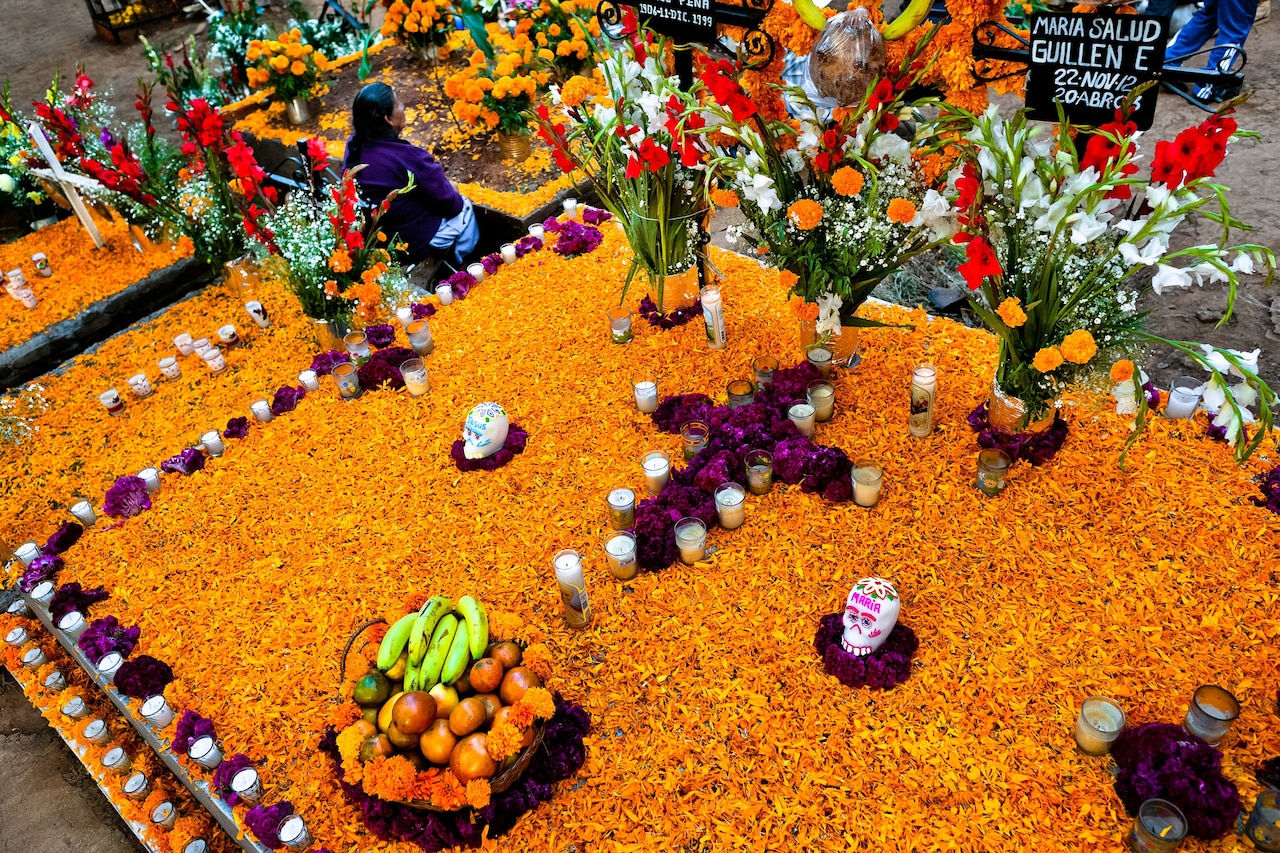
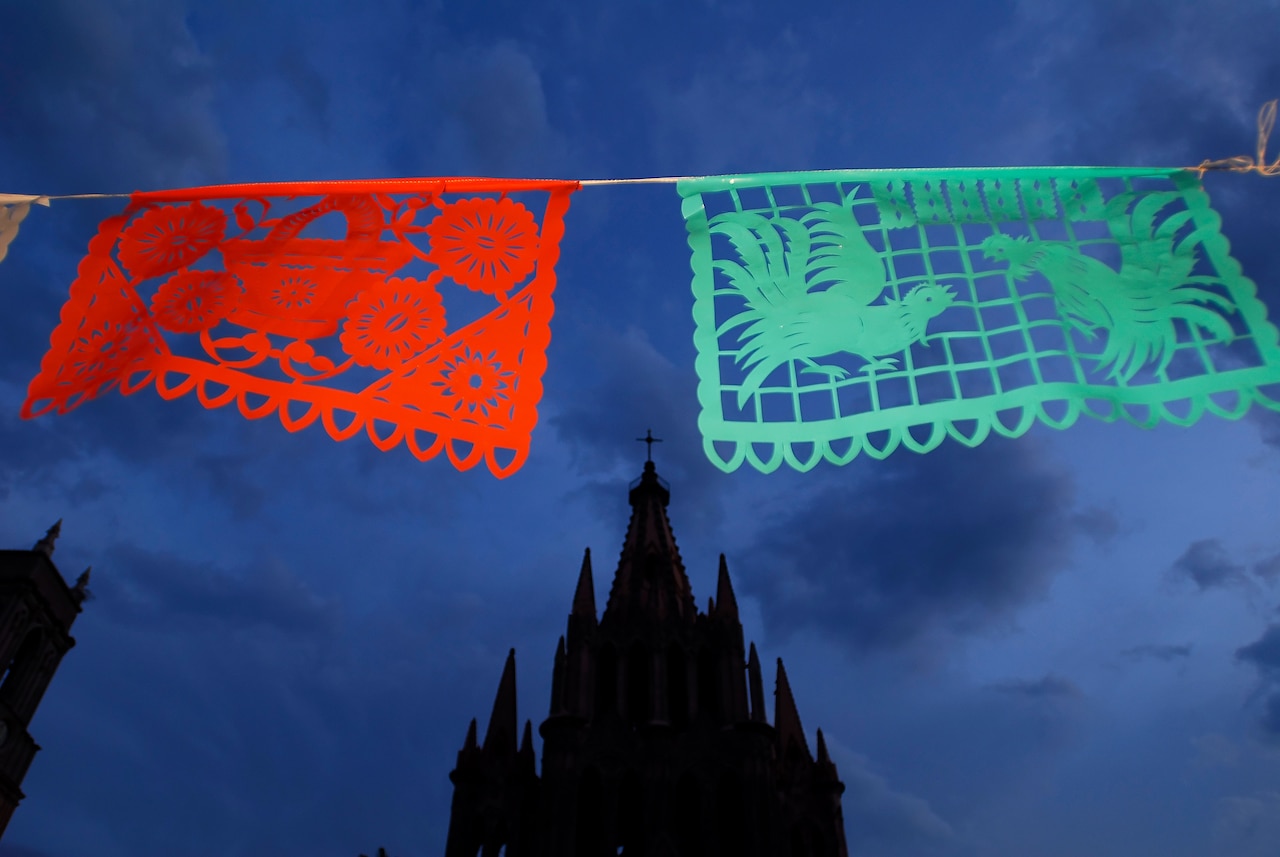
Left: Papel picado, or pierced papers, blow in the wind in San Miguel de Allende, Mexico. You can find papel picado around Mexico throughout the year, but especially around Day of the Dead.PHOTOGRAPH BY RAUL TOUZONRight: A Mexican woman sits at at a gravesite covered in marigolds and other flowers during a Day of the Dead celebration in Tzintzuntzan, Mexico.PHOTOGRAPH BY JAN SOCHOR, ALAMYhttps://272c8ec6a77a391c692dc789cef2bf21.safeframe.googlesyndication.com/safeframe/1-0-38/html/container.html
Thanks to efforts by the United Nations Educational, Scientific and Cultural Organization, or UNESCO, the term “cultural heritage” is not limited to monuments and collections of objects. It also includes living expressions of culture—traditions—passed down from generation to generation. In 2008, UNESCO recognized the importance of Día de los Muertos by adding the holiday to its list of Intangible Cultural Heritage of Humanity. Today Mexicans from all religious and ethnic backgrounds celebrate Día de los Muertos, but at its core, the holiday is a reaffirmation of indigenous life.
History

Day of the Dead originated several thousand years ago with the Aztec, Toltec, and other Nahua people, who considered mourning the dead disrespectful. For these pre-Hispanic cultures, death was a natural phase in life’s long continuum. The dead were still members of the community, kept alive in memory and spirit—and during Día de los Muertos, they temporarily returned to Earth. Today’s Día de los Muertos celebration is a mash-up of pre-Hispanic religious rites and Christian feasts. It takes place on November 1 and 2—All Saints’ Day and All Souls’ Day on the Catholic calendar—around the time of the fall maize harvest.
Altars
The centerpiece of the celebration is an altar, or ofrenda, built in private homes and cemeteries. These aren’t altars for worshipping; rather, they’re meant to welcome spirits back to the realm of the living. As such, they’re loaded with offerings—water to quench thirst after the long journey, food, family photos, and a candle for each dead relative. If one of the spirits is a child, you might find small toys on the altar. Marigolds are the main flowers used to decorate the altar. Scattered from altar to gravesite, marigold petals guide wandering souls back to their place of rest. The smoke from copal incense, made from tree resin, transmits praise and prayers and purifies the area around the altar.
Literary calaveras
Calavera means “skull.” But during the late 18th and early 19th centuries, calavera was used to describe short, humorous poems, which were often sarcastic tombstone epitaphs published in newspapers that poked fun at the living. These literary calaveras eventually became a popular part of Día de los Muertos celebrations. Today the practice is alive and well. You’ll find these clever, biting poems in print, read aloud, and broadcast on television and radio programs.
The calavera Catrina
In the early 20th century, Mexican political cartoonist and lithographer José Guadalupe Posada created an etching to accompany a literary calavera. Posada dressed his personification of death in fancy French garb and called it Calavera Garbancera, intending it as social commentary on Mexican society’s emulation of European sophistication. “Todos somos calaveras,” a quote commonly attributed to Posada, means “we are all skeletons.” Underneath all our manmade trappings, we are all the same.
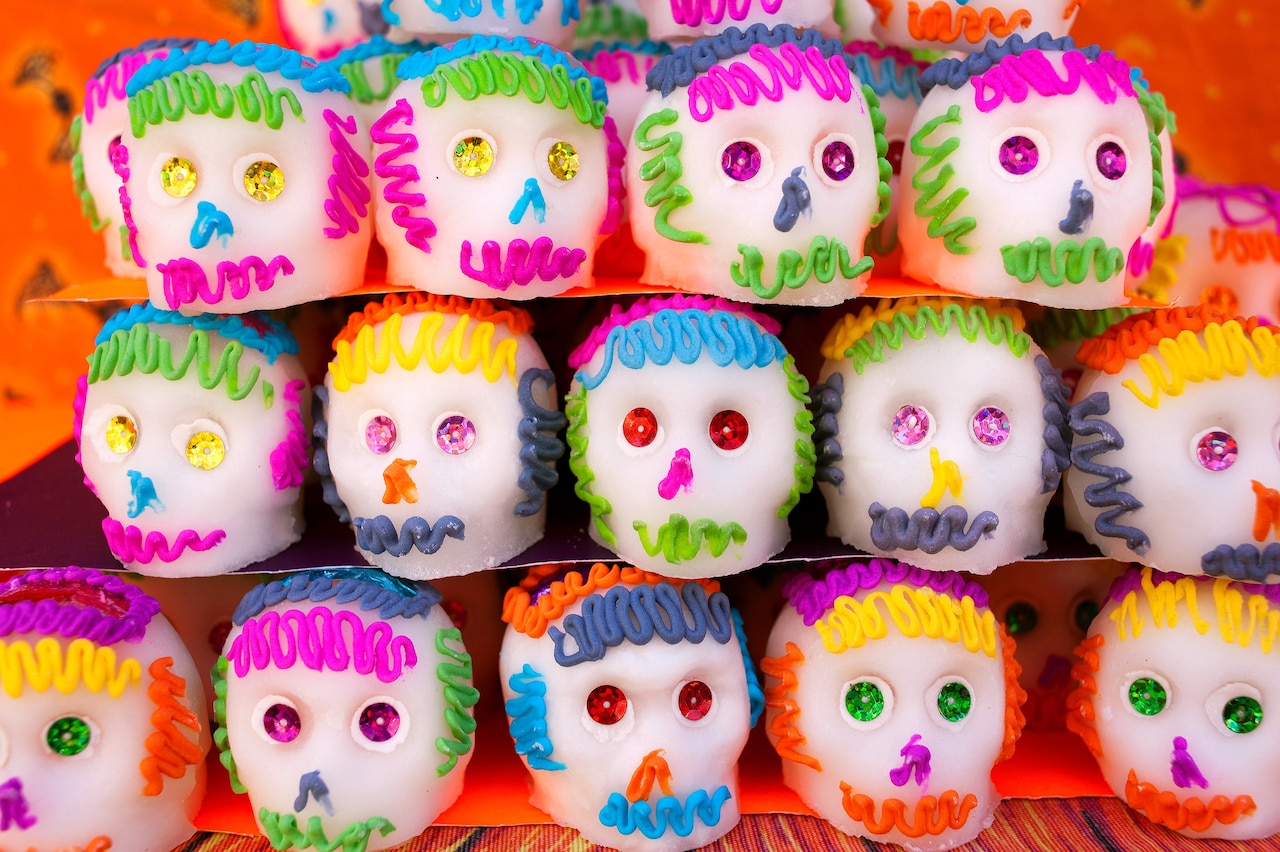
In 1947 artist Diego Rivera featured Posada’s stylized skeleton in his masterpiece mural “Dream of a Sunday Afternoon in Alameda Park.” Posada’s skeletal bust was dressed in a large feminine hat, and Rivera made his female and named her Catrina, slang for “the rich.” Today, the calavera Catrina, or elegant skull, is the Day of the Dead’s most ubiquitous symbol.
Food of the dead
You work up a mighty hunger and thirst traveling from the spirit world back to the realm of the living. At least that’s the traditional belief in Mexico. Some families place their dead loved one’s favorite meal on the altar. Other common offerings:
Pan de muerto, or bread of the dead, is a typical sweet bread (pan dulce), often featuring anise seeds and decorated with bones and skulls made from dough. The bones might be arranged in a circle, as in the circle of life. Tiny dough teardrops symbolize sorrow. [Read more about Pan de muerto.]
Sugar skulls are part of a sugar art tradition brought by 17th-century Italian missionaries. Pressed in molds and decorated with crystalline colors, they come in all sizes and levels of complexity.
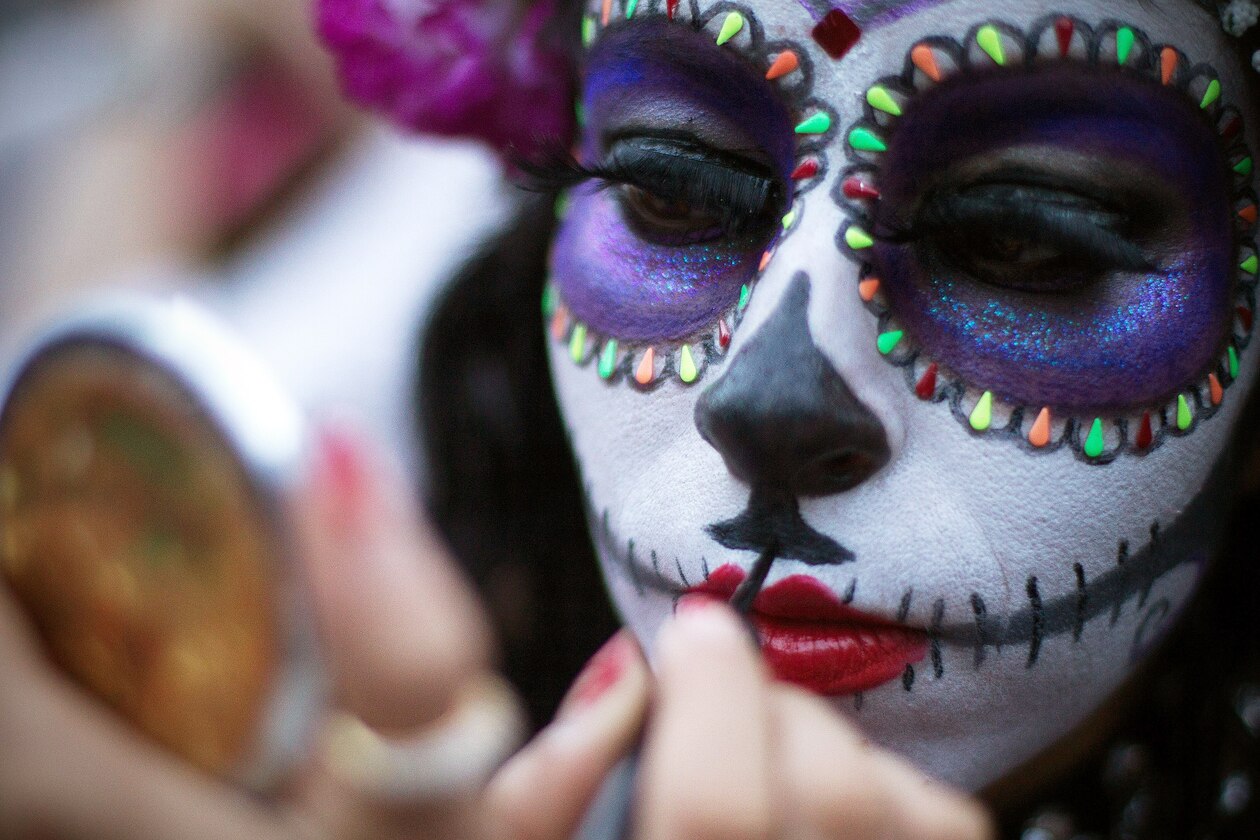
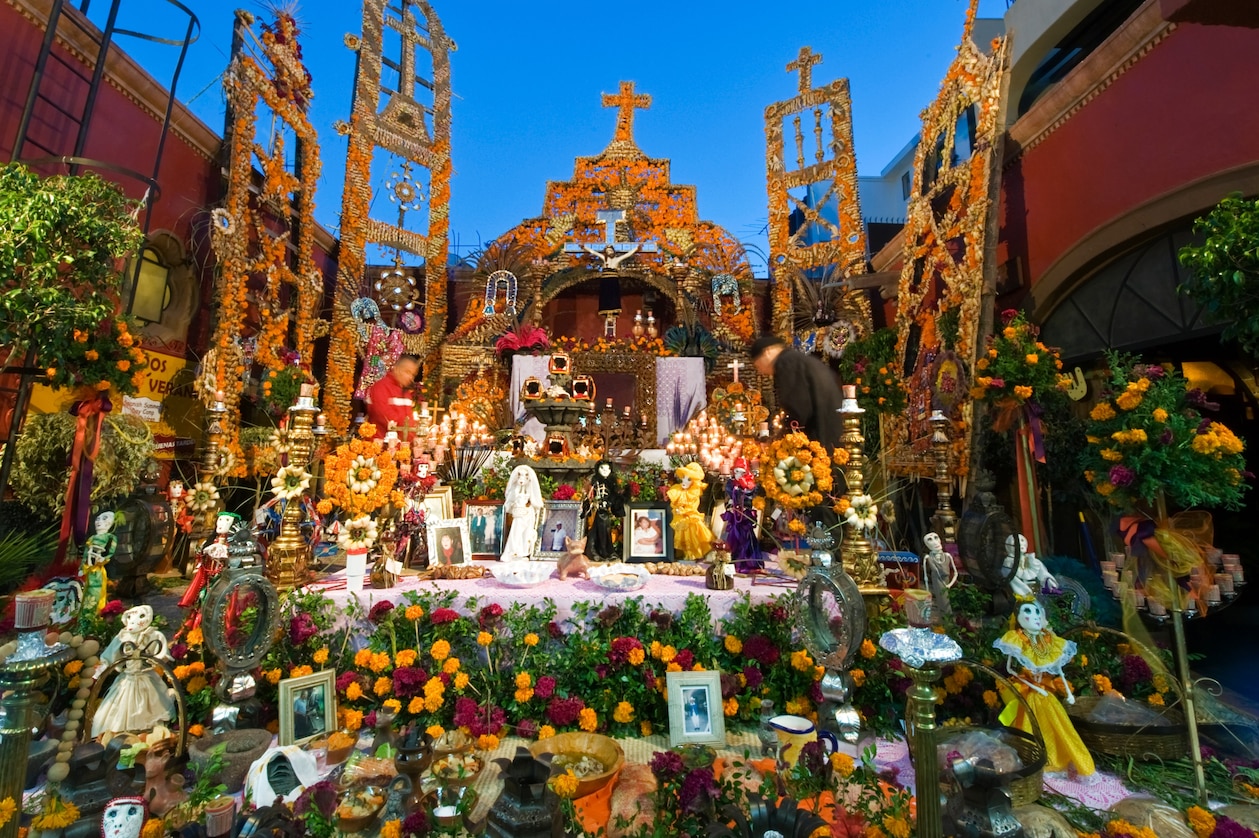
Left: Marigolds and family photos decorate a Day of the Dead altar in San Miguel de Allende, Mexico.PHOTOGRAPH BY CORBIS DOCUMENTARY/GETTY IMAGESRight: A woman adds finishing touches on her Catrina makeup ahead of the Catrinas Parade in Mexico City, Mexico.PHOTOGRAPH BY ALEJANDRO AYALA XINHUA, EYEVINE/REDUXhttps://272c8ec6a77a391c692dc789cef2bf21.safeframe.googlesyndication.com/safeframe/1-0-38/html/container.html
Drinks, including pulque, a sweet fermented beverage made from the agave sap; atole, a thin warm porridge made from corn flour, with unrefined cane sugar, cinnamon, and vanilla added; and hot chocolate.
Costumes
Day of the Dead is an extremely social holiday that spills into streets and public squares at all hours of the day and night. Dressing up as skeletons is part of the fun. People of all ages have their faces artfully painted to resemble skulls, and, mimicking the calavera Catrina, they don suits and fancy dresses. Many revelers wear shells or other noisemakers to amp up the excitement—and also possibly to rouse the dead and keep them close during the fun.
Papel picado
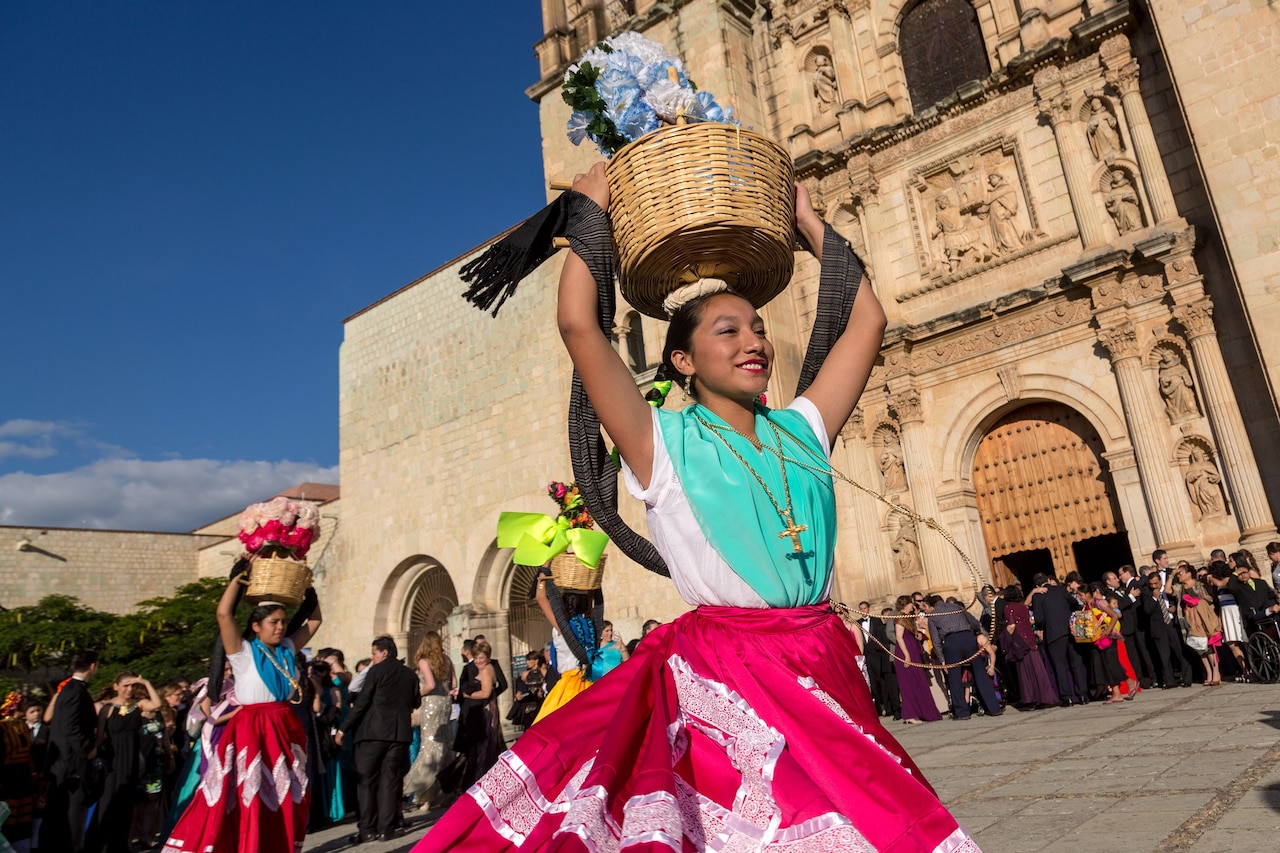
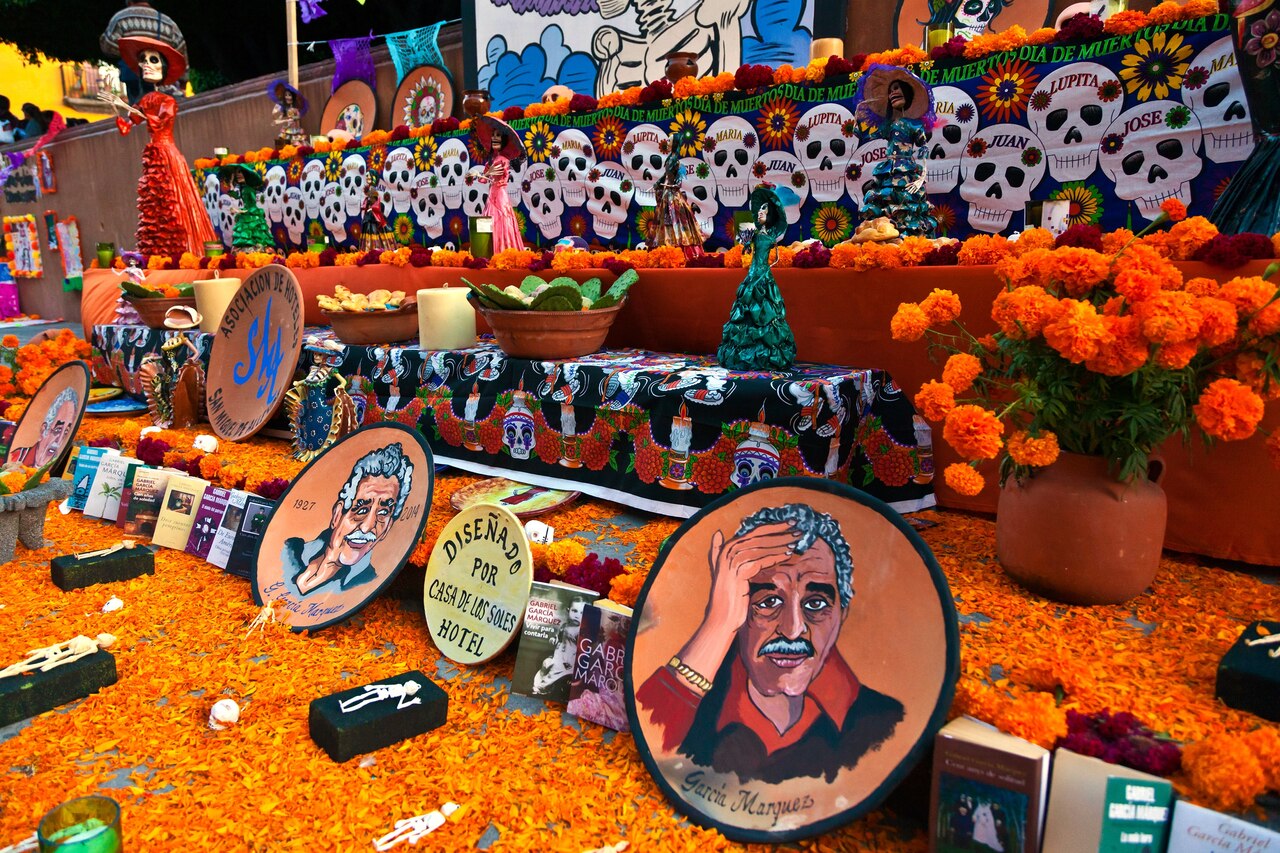
Left: Likenesses of author Gabriel García Márquez line an altar in San Miguel de Allende, Mexico.PHOTOGRAPH BY CRAIG LOVELL, EAGLE VISIONS PHOTOGRAPHY/ALAMYRight: Dancers in traditional costumes perform in front of the Santo Domingo church in Oaxaca, Mexico.PHOTOGRAPH BY RICHARD ELLIS, ALAMYhttps://272c8ec6a77a391c692dc789cef2bf21.safeframe.googlesyndication.com/safeframe/1-0-38/html/container.html
You’ve probably seen this beautiful Mexican paper craft plenty of times in stateside Mexican restaurants. The literal translation, pierced paper, perfectly describes how it’s made. Artisans stack colored tissue paper in dozens of layers, then perforate the layers with hammer and chisel points. Papel picado isn’t used exclusively during Day of the Dead, but it plays an important role in the holiday. Draped around altars and in the streets, the art represents the wind and the fragility of life.
Day of the Dead today
Thanks to recognition by UNESCO and the global sharing of information, Día de los Muertos is more popular than ever—in Mexico and, increasingly, abroad. For more than a dozen years, the New York-based nonprofit cultural organization Mano a Mano: Mexican Culture Without Borders has staged the city’s largest Day of the Dead celebration. But the most authentic celebrations take place in Mexico. If you find yourself in Mexico City the weekend before Day of the Dead this year, make sure to stop by the grand parade where you can join in on live music, bike rides and other activities in celebration throughout the city.
Countless communities in Mexico celebrate Day of the Dead, but styles and customs differ by region, depending on the region’s predominant pre-Hispanic culture. Here are a few places that stand out for their colorful and moving celebrations:NAT GEO EXPEDITIONSBook your next trip with Peace of MindSEARCH TRIPS
Pátzcuaro: One of the most moving Day of the Dead celebrations takes place each year in Pátzcuaro, a municipality in the state of Michoacán about 225 miles west of Mexico City. Indigenous people from the countryside converge on the shores of Pátzcuaro Lake, where they pile into canoes, a single candle burning in each bow, and paddle over to a tiny island called Janitzio for an all-night vigil in an indigenous cemetery.
Mixquic: In this Mexico City suburb, bells from the historic Augustinian convent toll and community members bearing candles and flowers process to the local cemetery, where they clean and decorate the graves of their loved ones.https://272c8ec6a77a391c692dc789cef2bf21.safeframe.googlesyndication.com/safeframe/1-0-38/html/container.html
Tuxtepec: This small city in the northeastern part of Oaxaca state is best known for its sawdust rugs. For days, locals painstakingly arrange colored sawdust, flower petals, rice, pine needles, and other organic materials in elaborate, ruglike patterns on city streets. Traditionally made for important processions, Tuxtepec’s sawdust rugs are judged in a contest held during Día de los Muertos.
Aguascalientes: Located roughly 140 miles north of Guadalajara, Aguascalientes—birthplace of engraver José Guadalupe Posada—stretches its Day of the Dead celebrations to nearly a week during its Festival de Calaveras (Festival of Skulls). The festival culminates in a grand parade of skulls along Avenida Madero.
RELATED: Beautiful Photos of Day of the Dead

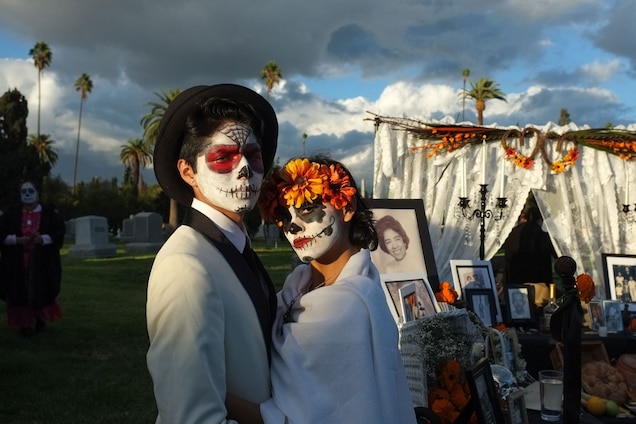
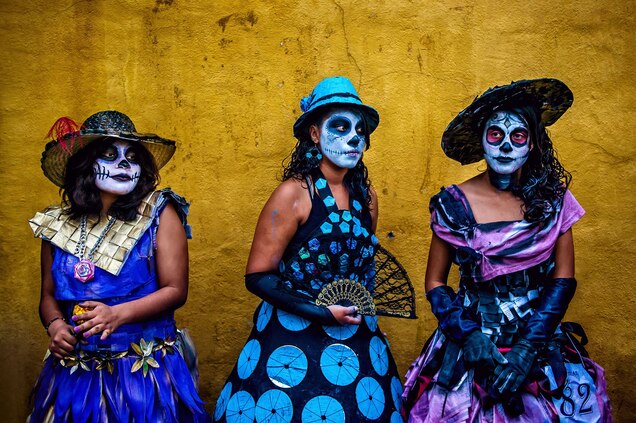





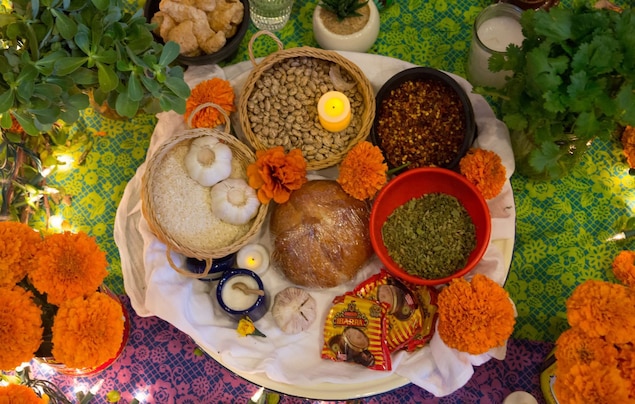
1 / 18<p>A Catrina and Catrin pose before an <i>ofrenda</i>, an altar set for deceased loved ones. Ofrendas display portraits, crosses, candles, flowers, incense, and water, a refreshment for the spirits who have made the long trip home from the hereafter.</p>
A Catrina and Catrin pose before an ofrenda, an altar set for deceased loved ones. Ofrendas display portraits, crosses, candles, flowers, incense, and water, a refreshment for the spirits who have made the long trip home from the hereafter.PHOTOGRAPH BY AUSTIN BEAHM, NATIONAL GEOGRAPHIC YOUR SHOT



